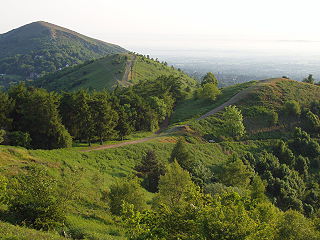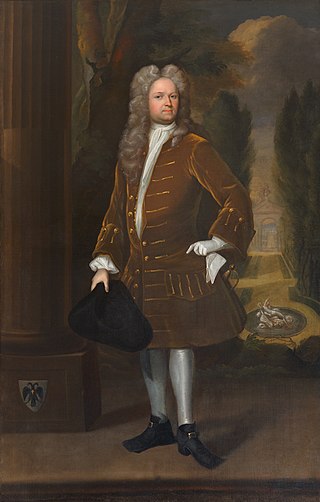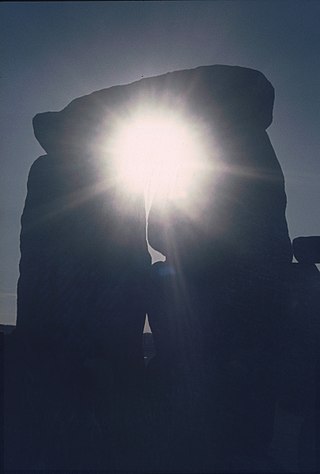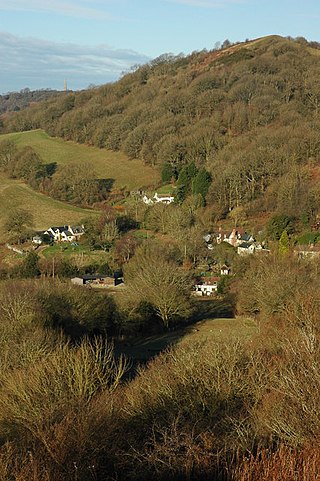
Stonehenge is a prehistoric megalithic structure on Salisbury Plain in Wiltshire, England, two miles (3 km) west of Amesbury. It consists of an outer ring of vertical sarsen standing stones, each around 13 feet (4.0 m) high, seven feet (2.1 m) wide, and weighing around 25 tons, topped by connecting horizontal lintel stones. Inside is a ring of smaller bluestones. Inside these are free-standing trilithons, two bulkier vertical sarsens joined by one lintel. The whole monument, now ruinous, is aligned towards the sunrise on the summer solstice and sunset on the winter solstice. The stones are set within earthworks in the middle of the densest complex of Neolithic and Bronze Age monuments in England, including several hundred tumuli.

Ley lines are straight alignments drawn between various historic structures, prehistoric sites and prominent landmarks. The idea was developed in early 20th-century Europe, with ley line believers arguing that these alignments were recognised by ancient societies that deliberately erected structures along them. Since the 1960s, members of the Earth Mysteries movement and other esoteric traditions have commonly believed that such ley lines demarcate "earth energies" and serve as guides for alien spacecraft. Archaeologists and scientists regard ley lines as an example of pseudoarchaeology and pseudoscience.

William Stukeley was an English antiquarian, physician and Anglican clergyman. A significant influence on the later development of archaeology, he pioneered the scholarly investigation of the prehistoric monuments of Stonehenge and Avebury in Wiltshire. He published over twenty books on archaeology and other subjects during his lifetime. Born in Holbeach, Lincolnshire, as the son of a lawyer, Stukeley worked in his father's law business before attending Saint Benet's College, Cambridge. In 1709, he began studying medicine at St Thomas' Hospital, Southwark, before working as a general practitioner in Boston, Lincolnshire.

Avebury is a Neolithic henge monument containing three stone circles, around the village of Avebury in Wiltshire, in southwest England. One of the best known prehistoric sites in Britain, it contains the largest megalithic stone circle in the world. It is both a tourist attraction and a place of religious importance to contemporary pagans.

The Medway Megaliths, sometimes termed the Kentish Megaliths, are a group of Early Neolithic chambered long barrows and other megalithic monuments located in the lower valley of the River Medway in Kent, South-East England. Constructed from local sarsen stone and soil between the 4th and 3rd millennia BCE, they represent the only known prehistoric megalithic group in eastern England and the most south-easterly group in Britain.

Kit's Coty House or Kit's Coty is a chambered long barrow near the village of Aylesford in the southeastern English county of Kent. Constructed circa 4000 BCE, during the Early Neolithic period of British prehistory, today it survives in a ruined state.

The Rollright Stones are a complex of three Neolithic and Bronze Age megalithic monuments near the village of Long Compton, on the borders of Oxfordshire and Warwickshire. Constructed from local oolitic limestone, the three monuments, now known as the King's Men and the Whispering Knights in Oxfordshire and the King Stone in Warwickshire, are distinct in their design and purpose. They were built at different periods in late prehistory. During the period when the three monuments were erected, there was a continuous tradition of ritual behaviour on sacred ground, from the 4th to the 2nd millennium BCE.
The Old Straight Track: Its Mounds, Beacons, Moats, Sites and Mark Stones is a book by Alfred Watkins, first published in 1925, describing the existence of alleged ley lines in Great Britain.
The megalithic yard is a hypothetical ancient unit of length equal to about 2.72 feet (0.83 m). Some researchers believe it was used in the construction of megalithic structures. The proposal was made by Alexander Thom as a result of his surveys of 600 megalithic sites in England, Scotland, Wales and Brittany. Thom also proposed the megalithic rod of 2.5 megalithic yards, or on average across sites 6.77625 feet. As subunits of these, he further proposed the megalithic inch of 2.073 centimetres (0.816 in), one hundred of which are included in a megalithic rod, and forty of which composed a megalithic yard. Thom applied the statistical lumped variance test of J.R. Broadbent on this quantum and found the results significant, while others have challenged his statistical analysis and suggested that Thom's evidence can be explained in other ways, for instance that the supposed megalithic yard is in fact the average length of a pace.

The prehistoric monument of Stonehenge has long been studied for its possible connections with ancient astronomy. The site is aligned in the direction of the sunrise of the summer solstice and the sunset of the winter solstice, and its latitude in respect to the Great Pyramid and Equator is precisely defined by the silver ratio. Archaeoastronomers have made a range of further claims about the site's connection to astronomy, its meaning, and its use.

John Frederick Carden Michell was an English author and esotericist who was a prominent figure in the development of the pseudoscientific Earth mysteries movement. Over the course of his life he published over forty books on an array of different subjects, being a proponent of the Traditionalist school of esoteric thought.

An alignment in archaeology is a co-linear arrangement of features or structures with external landmarks, in archaeoastronomy the term may refer to an alignment with an astronomically significant point or axis.

Stonehenge has been the subject of many theories about its origin, ranging from the academic worlds of archaeology to explanations from mythology and the paranormal.
Paul Devereux is a British author, researcher, lecturer, broadcaster, artist and photographer based in the UK. Devereux is a co-founder and the managing editor of the academic publication Time & Mind – the Journal of Archaeology, Consciousness and Culture, a research associate with the Royal College of Art (2007–2013), and a Research Fellow with the International Consciousness Research Laboratories (ICRL) group at Princeton University.
A landscape zodiac is a purported map of the stars on a gigantic scale, formed by features in the landscape, such as roads, streams and field boundaries. Perhaps the best known alleged example is the Glastonbury Temple of the Stars, situated around Glastonbury in Somerset, England. The temple is thought by some to depict a colossal zodiac.

Alfred Watkins was an English businessman and amateur archaeologist who developed the idea of ley lines.

Druidry, sometimes termed Druidism, is a modern spiritual or religious movement that promotes the cultivation of honorable relationships with the physical landscapes, flora, fauna, and diverse peoples of the world, as well as with nature deities, and spirits of nature and place. Theological beliefs among modern Druids are diverse; however, all modern Druids venerate the divine essence of nature.
John Francis Hitching (1933–2018) was a British author, dowser, journalist and filmmaker.

Whiteleaved Oak is a hamlet in the English county of Herefordshire, lying in a valley at the southern end of the Malvern Hills between Raggedstone Hill and Chase End Hill where the counties of Herefordshire, Worcestershire and Gloucestershire meet. It was home to a 500-year-old oak tree, which was thought to be sacred. On 9 July 2020, the tree was destroyed by a fire which broke out due to lanterns being hung on its branches.
Terence Meaden is an English author who writes on archaeoastronomy, mostly focusing on the megalithic sites of Avebury, Stonehenge and the Drombeg stone circle in Cork, Ireland. He is a retired physicist with a doctoral degrees in physics from the University of Oxford and a master's degree in applied landscape archaeology also from University of Oxford. Meaden is influenced by the work of archaeologist Marija Gimbutas who wrote about the Goddess worshipping Neolithic and Bronze Age cultures of "Old Europe".














